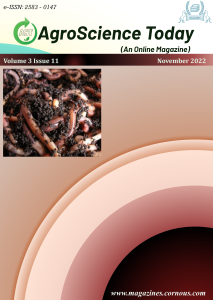Sitamarhi districts of north Bihar situated in northern part of Bihar state; it’s also connected with international boarder of Nepal. Awareness regarding impotence of diet in human health is increasing day-by-day. Bihar has emerged as a state in fisheries and aquaculture sector in India through development and production of host technologies for increasing fish production. Even with vast in increasing in production over the year it’s able to provide about 9kg/ kaput to percent population (taking 56% at fish eater) against nutritional requirement of 11kg / kaput. The study focuses on the constraints on fish production in Bihar. It has vast water reservoirs in the form of river, lakes, ponds and reservoirs. The utilisation of compound water resources is 2.3 lakh ha. Although there are a good amount of transferable technologies available for transfer in farmer’s field, there are some constraints in transfer of fishery technology, they are: (i) Flood (ii) Presence of Wet Land (iii) Unavailability Quality fish seed (iv) Unorganised marketing (v) Poor infrastructure facilities (vi) Poor cold chain maintenance (vii) Lack of awareness about scientific fish farming (viii) Lack of extension activities (ix) Dominance of Bighead (Aristichthys nobilis) species.
Vermicomposting is considered as a quality input in organic farming and it is considered residue free. Most of us know that fresh waste can directly be used for vermicomposting but it needs pre-composting. Addition of waste materials without pre-composting will increase the temperature up to 75 degree Celsius. In this temperature the earthworm gets killed. Hence it should be pre-composted for 30 days by mixing cow dung slurry with waste at the ratio of 3:1. This means that every three parts of waste and one part of cow dung slurry should be mixed and heaped for thirty days to reduce heat formation in the bed.
A study was conducted in Mainpuri district with the objective to find out the socio-economic gap noticed in women ex-trainess who had under taken training arrangement by KVK, Mainpuri. Selection of district, block, panchayat, village and respondents has been done by purposive and random sampling procedure. The selected sample size was 120. Data was collected from each individual respondent through pretested interview schedule and use suitable statistical tools like Frequency, Rank order, Percentage and Mean average score, Percentage increase etc. Were used in the research study it was found that 49.17 percentages of trainee respondents were of young age group. Education level at primary level was 53.33 percent and 65.84 percent respondents were having joint family type and 79 percent of families had more than 4 members. Occupation of 48.34 percent of respondent was farming and 53.33 percent of the sample respondents had semi pucca housing pattern. Annual income was (5000-20000) for 48.33 percent of respondent and 68.33 percent respondents were marginal farmers with land (up to 1 ha.) 68.33 percent. 44.16 percent of respondent had draft animas like buffalo and scientific aspiration gap in social participation of the respondents was 61 percent. In this study it was observed that many actions of women training like training contents, approaches, consciousness, exposure visits etc. It were not adequately performed by the KVK for the broad improvement of women.
